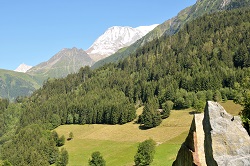Mitigating forest mismanagement with 3D mapping
35 % of Europe is covered by mountains, many of which are blanketed by dense forests. For the many Europeans who live in these mountainous areas, the forest and the land are often the main sources of income, thus representing an important economic resource. Unfortunately, these same regions are all-too-often victims of mismanagement and deforestation - with significant economic consequences for local communities. To mitigate against this trend, the SLOPE project aims to improve the long-term management and sustainability of Europe’s mountains and forests by providing local communities and forest administrations more precise knowledge about forest ecosystems. It intends to do this by generating detailed, virtual 3D forest models using geospatial information that combines data gathered from traditional in-the-field laser scanning technology with new, state-of-the-art UAV-based aerial surveying systems. Transformation through technology ‘With SLOPE, we intend to transform Europe’s forestry industry from one that has traditionally been resource-intensive to one that is knowledge-based and sustainable,’ says Senior Research Manager and Project Coordinator Daniele Magliocchetti from GraphiTech, Italy. ‘And in doing so, we will help make the European timber industry more competitive at the global level.’ Like many research projects, SLOPE was born out of a perceived problem. Project researchers identified numerous weaknesses in the forest production workflow. For example, the forestry workflow lacks efficient ways for finding the best tree type for a particular demand, correctly placing a cable line to maximise harvesting and minimise setup time, tracking the amount of produced wood, and deciding the best logistic solutions to optimise costs. ‘All of these areas are ripe for improvement if the end user has the necessary information readily available,’ says Magliocchetti. SLOPE represents a new way of planning forest activities specifically designed for steep and sloped mountain areas, allowing the user to ‘see’ the forest’s true characteristics via a 3D model. To create these models, the project uses UAVs (Unmanned Aerial Vehicle) and satellites to produce images, which serve as the source of the spatial information that the system then uses to determine the quality of a particular parcel of land and the position, height and species of each tree. From here, the adoption of RFID (radio-frequency identification system) tags serves as the starting point for the population of the Digital Forest Model - giving each tree marked by foresters a unique digital tracking number. An enhanced cable carriage system updates each tree within the database with a harvesting stamp and every log produced from that particular tree, thanks to a sensor-enabled processor head, receives a specific RFID tag and quality grade, allowing it to be tracked along the entire journey to the end customer. Put this technology together and the SLOPE Forest Information System (FIS) is capable of aligning data originated from different sources into a common forest data model visualised in 3D – providing the end user with a complete picture of the forest scenario. ‘Using the SLOPE FIS, forest owners and operators can obtain more detailed data about a forest property, which can be used in their planning and inventory phase without the need to conduct direct, in-the-field examinations - saving time and costs,’ explains Magliocchetti. Big benefits SMEs in particular are set to benefit immensely from the SLOPE system. Prior to SLOPE, many SMEs were unable to conduct the required surveying of mountain forests due to cost restrictions. ‘Because of SLOPE’s integration of a variety of innovative, cost-effective methods and tools designed specifically for mountainous forest management, these small and medium sized companies now have access to unprecedented knowledge, giving them a unique ‘first mover’ advantage in their markets,’ says Magliocchetti. Magliocchetti also believes the system could play a role in increasing employment in less developed mountain areas. Furthermore, the project will help develop stronger relations between local populations and sustainable land use - showing that with SLOPE, one truly can see the forest through the trees. For more information please see: project website
Countries
Italy



